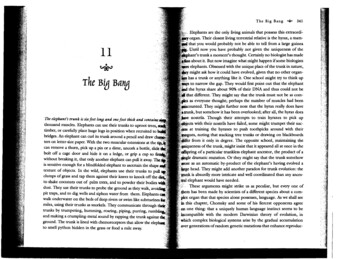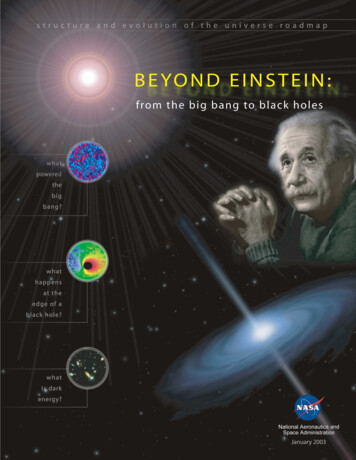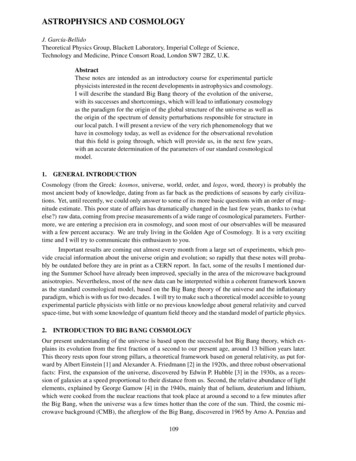
Transcription
The Big Bang .11 The B BangThe elephlmrs trunk is six feet long and one foot thick and containfthousand muscles. Elephants can use their trunks to uproot trees,timber, or carefully place huge logs in position when recruited tobridges. An elephant can curl its trunk around a pencil and drawters on letter-size paper. With the two muscular extensions at thecan remove a thorn, pick up a pin or a dime, uncork a bottle, slidebolt off a cage door and hide it on a ledge, or grip a cup sowithout breaking it, that only another elephant can pull it away.is sensitive enough for a blindfolded elephant to ascertain the shapetexture of objects. In the wild, elephants use their trunks to pullclumps of grass and tap them against their knees to knock off theto shake coconuts out of palm trees, and to powder their bodiesdust. They use their trunks to probe the ground as they walk,pit traps, and to dig wells and siphon water from them. Elephantswalk underwater on the beds ofdeep rivers or swim like submarinesmiles, using their trunks as snorkels. They communicate throughtrunks by trumpeting, humming, roaring, piping, purring,and making a crumpling-metal sound by rapping the trunk againstground. The trunk is lined with chemoreceptors that allow the elenrumto smell python hidden in the grass or fOod a mile away.341Elephants are the only living animals that possess this extraordi organ. Their closest living terrestrial relative is the hyrax, a mam that you would probably not be able to tell from a large guioea ntil now you have probably not given the uniqueness of theLant's trunk a moment's thought. Certainly no biologist has madeabout it. But now imagine what might happen ifsome biologistselephants. Obsessed with the unique place ofthe trunk in nature,might ask how it could have evolved, given that no other organhas a trunk or anything like it. One school might try to think upto narrow the gap. They would first point out that the elephant.the hyrax share about 90% of their DNA and thus could not bethat different. They might say that the trunk must not be as com as everyone thought; perhaps the number ofmuscles had beeniscounted. They might further note that the hyrax really does havebut somehow it has been overlooked; after all, the hyrax doesnostrils. Though their attempts to train hyraxes to pick upwith their nostrils have failed, some might trumpet their suc at training the hyraxes to push toothpicks around with theirnoting that stacking tree trunks or drawing on blackboardsfrom it only in degree. The opposite school, maintaining the.piqueness ofthe trunk, might insist that it appeared all at once in theoffspring of a particular trunkless elephant ancestor, the product of adramatic mu,tation. Or they might say that the trunk somehowas an automatic by-product of the elephant's having evolved ahead. They might add another paradox for trunk evolution: theabsurdly more intricate and well coordinated than any ances elephant would have needed.These arguments might strike us as peculiar, but every one of em has been made by scientists of a different species about a com plex organ that that species alone possesses, language. As we shall seethis chapter, Chomsky and some of his fiercest opponents agreeone thing: that a uniquely human language instinct seems to be.iocompatible with the modem Darwinian theory of evolution, inWhich complex biological systems arise by the gradual accumulationQver generations ofrandom genetic mutations that enhance reproduc
342. The Language Instincttive success. Either there is no language instinct, or it must haveevolved by other means. Since I have been trying to convince you thatthere is a language instinct but would certainly forgive you if youwould rather believe Darwin than believe me, I would also like toconvince you that you need not make that choice. Though we knowfew details about how the language instinct evolved, there is no reasonto doubt that the principal explanation is the same as ror any othercomplex instinct or organ, Darwin's theory of natural selection.Language is obviously as different from other animals' communica tion systems· as the elephant's trunk is different from other animals'nostrils. Nonhuman communication systems are based on one ofthree designs: a finite repertory. ofcalls (one ror warnings ofpredators,one for claims to territory, and so on), a continuous analog signal thatregisters the magnitude of some state (the livelier the dance of thebee, the richer the food source that it is telling its hivemates about),or a series of random variations on a theme (a birdsong repeated witha new twist each time: Charlie Parker with feathers). As we have seen,human language has a very different design. The discrete combinatocrial system Called "grammar" makes human language infinite (there is·no limit to the number ofcomplex words or sentence in a language),digital (this infinity is achieved by rearranging discrete elements inparticular orders and combinations, not by varying some signal alonga continuum like the mercury in a thermometer), andcompositiona.l(each of the infinite combinations has a different meaning predictabit;from the meanings of its parts and the rules and principles arrangingthem).Even the seat ofhuman language in the brain is special. The vocaJcalls of primates are controlled not by their cerebral cortex but.byphylogenetically older neural structures in the brain stem and limbi systems, structures that are heavily involved in emotion. H ivocalizations other language, like sobbing, laughing, moaning.and shouting in pain, are also controlled subcortically.structures even control the swearing that follows the arrival of amer on a thumb, that emerges as an involuntary tic in Tourette's syn,The Big Bang .343drome, and that can survive as Broca's aphasics' only speech. Genuinelanguage, as we saw in the preceding chapter, is seated in the cerebralcortex, Primarily the left perisylvian region.Some psychologists believe that changes in the vocal organs andin the neural circuitry that produces and perceives· speech sounds arethe onb'aspects oflanguage that evolved in our species. On this view,there are a few general learning abilities found throughout the animalkingdom, and they work most efficiendy in humans. At some point inhistory language was invented and refined, and we have been learningit ever since. The idea that species-specific behavior is caused byanat omy and general intelligence is captured in the Gary Larson Fllr Sidecartoon in which two bears hide behind a tree near a human couplerelaxing on a blanket. One says: "C'mon! Look at these fangs! . . .lQok at these claws! . You think we're supposed to eat just honeyand berries?"According to this view, chimpanzees are the second-best learnersin the animal kingdom, so they should be able to acquire a languagetoo, albeit a simpler one. AU it takes is a teacher. In the 1930s and1940s two psychologist couples adopted baby chimpanzees. Thechimps became part of the f.unily and learned to dress, use the toilet,brush their teeth, and wash the dishes. One of them, Gua, was raisedalongside a boy of the same age but never spoke a word. The other,\ftki, was given arduous training in speech, mainly by the foster par eilts' mOulding the puzzled chimp's lips and tongue into the right hapes. With a lot of practice, and often with the help of her own ds, Vtki learned to make three utterances that charita.ble listenersCQuid hear as PIIPII, mllmll, and cup, though she. often confused themwhen she got excited. She could respond to some stereotyped formu las, like Kiss me and Bring me the dog, but stared blankly when askedto act Out a novel combination like Kiss the dog.But Gua and Vtki were at a disadvantage: they were forced to usetheir vocal apparatus, which was not designed for speech and whichd:tey could not voluntarily control. Beginning in the late 1960s, sev eral f.unous projects claimed to have taught language to baby chim panzees with the help of more user-friendly media. (Baby chimps are
344.The Language Instinctused because the adults are not the hairy clowns in overalls you see ontelevision, but strong, vicious wild animals who have bitten fingers offseveral well-known psychologists.) Sarah learned to string magnetizedplastic shapes on a board. Lana and Kanzi learned to press buttonswith symbols on a large computer console or point to them on a por table tablet. Washoe and Koko (a gorilla) were said to have acquiredAmerican Sign Language. According to their trainers, these apeslearned hundreds of words, strung them together in meaningful sen tence, and coined new phrases, like water bird for a swan and· cookierock for a stale Danish. "Language is no longer the exclusive domainof man," said Koko's trainer, Francine (Penny) Patterson.These claims quickly captured the public's imagination and wereplayed up in popular science books and magazines and television prQ--:grams like National Geographic, Nopa, Sixty Minutes, and 20/20. Notonly did the projects seem to consummate our age-old yearning totalk to the animals, but the photo opportunities of attractive womencommuning with apes, evocative of the beauty-and-the-beast ar:che type, were not lost on the popular media. Some of the projectsweri: covered by People, Life, and Penthouse magazines, and they were fic tionalized in a bad movie starring Holly Hunter called Animal Behap ior and in a famous Pepsi commercial.Many scientists have also been captivated, seeing the projects asa healthy deflation of our species' arrogant chauvinism. I have seellpopular-science columns that list the acquisition oflanguage by chim panzees as one of the major scientific discoveries of the century. In lJrecent, widely excerpted book, Carl Sagan and Ann Druyan have usedthe ape language experiments as part of a call for us to reassess ourplace in nature:A sharp distinction between human beings and "animals" isessential if we are to bend them to our will, make them workfur us, wear them, eat them-without any disquieting tinges ofguilt or regret. With untroubled consciences, we can renderwhole species exrlnct-as we do today to the tune of 100speces a day. Their loss is oflittle import: Those beings, we tellThe lJig Bang.345ourselves, are not like us. An unbridgeable gap has thus a prac tical role to play beyond the mere stroking ofhuman egos. Isn'tthere much to be proud of in the lives of monkeys and apes?Shouldn't we be glad to acknowledge a connection withLeakey, Imo, or Kanzi? Remember those macaques who wouldrather go hungry then profit from harming their fellows; mightwe have a more optimistic view of the human future ifwe weresure our ethics were up to their standards? And, viewed fromthis perspective, how shall we judge our treatment ofmonkeysand apes?This well-meaning but misguided reasoning could only have COmefrom writers who are not biologists. Is it really "humility" for us tosave species from extinction because we think they are like us? 9 rbecause they seem like a bunch of nice guys? What al:lout aU thecreepy, nasty, selfish animals who do not remind us of urselves, orour image of what we would like to be-can we go ahea 1and wipethem out? And Sagan and Druyan ar: ' no friends of the apes if theythink the reason we s ou}.d treat the apes fairly is that they c . be ught human language. Like many other writers, Sagan and Droyaqare far too credulous about the claims of the chimpanzee trainers. als ar:.e pl'.one to, devel People who spend a lot of time with arum.·oping inc.1ulgent atp.tudes about their powers of communication. Mysreat-aunt Bella insisted in all sincerity that her Siamese cat Rustyup.derstoodEng:lish Many of the claims of the ape train rs were notmuch more sci ntific. qst ofthe trainers were. schooled in the behav iQrist tradition of B. F. Skinner and ar:e ignorant of the study of lan guage; they latched on to the most tc::nqoqs resemblance betweenchimp and child and proclaimed that eir abilities ar:e fundamentallythe same. The more enthusiastic trainers went over the heads ofscien tists and maQe their engaging case. directly to the public on theTonight ShOlf' and Nlltional Geographic. Patterson in partiCtU hasfQund ways to e cuse .{ okD's performance on the grounds that thegorilla is fonQ ofpuns, jokes, metaphors, and mischievous lies. Gener aUy the stronger the claims about the animal's abilities the skimpier
346.The Language Instinctthe data made available to the scientific community for evaluation.Most of the trainers have refused all requests to share their raw data,and Washoe's trainers, Beatrice and Alan Gardner, threatened to sueanother researcher because he used frames of one of their films (theonly raw data available to him) in a critical scientific article. Thatresearcher, Herbert Terrance, together with the psychologists LaraAnn Petitto, Richard Sanders, and Tom Bever, had tried to teach ASLto one of Washoe's relatives, whom they named Nim Chimpsky. Theycarefully tabulated and analyzed his signs, and Petitto, with the psy chologist Mark Seidenberg, also scrutinized the videotapes and whatpublished data there were on the other signing apes, whose abilitieswere similar to Nim's. More recently, Joel Wallman has written a his tory of the topic called Aping lAngUlJge. The moral of their investiga tion is: Don't believe everything you hear on the Tonight Show.To begin with, the apes did not "learn American Sign Lan guage." This preposterous claim is based on the myth that ASL' isacrude system of pantomimes and gestures rather than a full languag with complex phonology, morphology, and syntax. In fact the apeshad not learned any true ASL signs. The one deaf native signer on theWashoe team later made these candid remarks:Every time the chimp made a sign, we were supposed to writeit down in the log . They were always complaining becausemy log didn't show enough signs. All the hearing peopleturned in logs with long lists of signs. They always saw moresigns than I did. I watche really carefully. The chimp'shands were moving constantly. Maybe I missed something, butI don't think so. I just wasn't seeing any signs. The hearingpeople were logging every movement the chimp made as asign. Every time the chimp put his finger in his mouth, they'dsay "Oh, he's making the sign for drink,'" and they'd give himsome milk. When the chimp scratched itself, they'd recordit as the sign for scratch. . When [the chimps] want some thing, they reach. Sometimes [the trainers would] say, "Oh,amazing, look at that, it's exactly like the ASL sign for give!"It wasn't.The Big Bang.347To arrive at their vocabulary counts in the hundreds, the investigatorswould also "translate" the chimps' pointing as a sign for you, theirhugging as a sign for hug, their picking, tickling, and kissing as signsfor pick, tickle, and kiss. Often the same movement would be creditedto the chimps as diffi:rent ''words,'' depending on what the observersthought the appropriate word would be in the context. In the experi ments in which the chimps interacted with a computer console, thekey that the chimp had to press to initialize the computer· was trans lated as the word plellSe. Petitto estimates that with more standardcriteria the true vocabulary count would be closer to 25 than 125.Actually, what the chimps were really doing was more interestingthan what they were claimed to be doing. Jane Goodall, visiting theproject, remarked to Terrace and Petitto that every one of Nirn's so called signs was familiar to her from her observations of chimps in thewild. The chimps were relying heavily on the gestures in their naturalrepertoire, rather than learning true arbitrary ASL signs with theircombinatorial phonological structure of hand shapes, motions, loca tions, and orientations. Such backsliding is common when humanstrain animals. Two enterprising students ofB. F. Skinner, Keller andMarian Breland, took his principles for shaping the behavior of ratsand pigeons with schedules of reward and turned them into a lucrativecareer of training circus animals. They recounted their experiences ina famous article called "The Misbehavior of Organisms," a play onSkinner's book The Behavior of Organisms. In some of their acts theanimals were trained to insert poker chips in little juke boxes and ven ding machines for a food reward. Though the training schedules werethe same for the various animals, their species-specific instincts bledthrough. The chickens spontaneously pecked at the chips, the pigstossed and rooted them with their snouts, and the raccoons rubbedand washed them.The chimp's abilities at anything one would want to call gram mar were next to nil. Signs were not coordinated into the well-definedmotion contours of ASL and were not inflected for aspect, agreement,an4 so on-a striking omission, since inflection is the primary meansin ASL of conveying who did what to whom and many other kinds of
348 The Language InstinctThe Big Banginformation. The trainers frequendy claim that the chimps have syn tax, because pairs of signs are sometimes placed in One order moreoften than chance would predict, and because the brighter chimps canact out sequences like Would you please CIIrry the cooler to Penny. Butremember from the Loebner Prize competition (for the most convinc ing computer simulation of a conversational partner) how easy it is tofool people into thinking that their interlocutors have humanlike tal ents. To unde tand the request, the chimp could ignore the symbolswould, you, please, carry, the, and to; all the chimp had to notice wasthe order of the two nouns (and in most of the tests, not even that,because it is more natural to carry a cooler to a person than a personto a cooler). True, some of the chimps can carry out these commandsmore reliably than a two-year-old child, but this says more about tern.,perament than about grammar: the chimps are highly trained animalacts, and a two-year-old is a two-year-old.As fur as spontaneous output is concerned, there is no compari.-.SOn. Over several years of intensive training, the average length ofthe chimps' "sentences" remains constant. With nothing more thanexposure to speakers, the average length of a child's sentences shoo.tsoff like a rocket. Recall that typical sentences from a two-year-oldchild are Look at that train Ursula brought and Wegoing turn light (}If,so you can't see. Typical sentences from a language-trained chimp are:Nim eat Nim eat.Drink eat me Nim.Me gum me gum.Tickle me Nim play.Me eat me eat.Me banana you banana me you give.You me banana me banana you.Banana me me me eat.Give. orange me give eat orange me eat orange give me eatorange give me you.These jumbles bear scant resemblance to children's sentences. (Ry:watching long enough, of course, one is bound to find random.349binations in the chimps' gesturing that can be given sensible interpre tations, like water bird). But the strings do resemble animal behaviorin the wild. The zoologist E. O. Wtlson, summing up a survey ofanimal communication. remarked on its most striking property: ani mals, he said, are "repetitious to the point ofinanity."Even putting aside vocabulary, phonology, morphology, andsyntax, what impresses one the most about chimpanzee signing is thatfundamentally, deep down, chimps just don't "get it." They knowthat the trainers like them to sign and that signing often gets themwhat they want, but they never seem to feel in their bones what Ian.guage is and how to use it. They do not take turns in conversationbut instead blithely sign simultaneously with their partner, frequendyoffto the side or under a table rather than in the standardized signingspace in front of the body. (Chimps also like to sign with their feet,but no One blames them for taking advantage of this anatomical gift.)The chimps seldom sign spontaneously; they have to be molded,drilled, and coerced. Many of their "sentences," especially the OnesshOwing systematic ordering, are direct imitations ofwhat the trainerhas just signed, or minor variants of a small number of formulas thatthey have been trained On thousands of times. They do not evenclearly get the idea that a particular sign might refer to a kind ofobject. Most of the chimps' object signs can refer to any aspect of thesituation with which an object is typically associated. Toothbrush canmean "toothbrush," "toothpaste," "brushing teeth," "I want mytoothbrush," or "It's time for bed." Juice can mean "juice," "wherejuice is usually kept," or "Take me to where the juice is kept. " Recallfrom Ellen Markman's experiments in Chapter 5 that children usethese "thematic" associations when sorting pictures into groups, butthey ignore them when learning word meanings; to them, a dllX is adog or another dog, not a dog or its bone. Also, the chimps rarelymake statements that comment On interesting objects or actions; vir tually all their signs are demands for something they want, usuallyfood or tickling. I cannot help but think of a moment with my two year-old niece Eva that captures how different are the minds of child.and chimp One night the family was driving on an expressway, and
350 . The Language Instinctwhen the adult conversation died down, a tiny voice from the backseat said, "Pink." I fullowed her gaze, and on the horizon severalmiles away I could make out a pink neon sign. She was commentingon its color, JUSt for the sake of commenting on its color.Within the field of psychology, most of the ambitious claimsabout chimpanzee language are a thing ofthe past. Nim's trainer Her bert Terrace, as mentioned, turned from enthusiast to whistle-blower.David Premack, Sarah's trainer, does not claim that what she acquiredis comparable to human language; he uses the symbol system as a toolto do chimpanzee cognitive psychology. The Gardners and Pattersonhave distanced themselves from the community ofscientific discourse:for over a decade. Only one team is currently making claims aboutlanguage. Sue Savage-Rumbaugh and Duane Rumbaugh concedethat the chimps they trained at the computer console did not learnmuch. But they are now claiming that a different variety of chimpan zee does much better. Chimpanzees come from some half a dozenmutually isolated "islands" of forest in the west African continent,and the groups have diverged over the past million years to the pointwhere some of the groups are sometimes classified as belonging todifferent species. Most of the trained chimps were "commonchimps"; Kanzi is a "pygmy chimp" or "bonobo," and he learnedto bang on visual symbols on a portable tablet. Kanzi, says Savage.Rumbaugh, does substantially better at learning symbols (and atunderstanding spoken language) than common chimps. Why hewould be expected to do so much better than members of his siblingspecies is not clear; contrary to some reports in the press, pygmychimps are no more closely related to humans than common chimpsare. Kanzi is said to have learned his graphic symbols without having.been laboriously trained on them-but he was at his mother's sidewatching while she was laboriously trained on them (unsuccessfully).He is said to use the symbols for purposes other than requesting.hUlat best only four percent of the time. He is said to use three-symbol"sentences"-but they are really fixed funnulas with no internal st:1'UC ture and are not even three symbols long. The so-called sentences all chains like the symbol for chase followed by the symbol for hideThe Big Bang .351followed by a point to the person Kanzi wants to do the chasing andhiding. Kanzi's language abilities, ifone is being charitable, are abovethose of his common cousins by a just-noticeable difference, but nomore.What an irony it is that the supposed attempt to bring Homosapiens down a few notches in the natural order has taken the fonn ofUS humans hectoring another species into emulating our instinctive(onn of communication, or some artificial fonn we have. invented, asif mat were the me ure of biological worth. The chimpanze ' resis tance is no shame on them; a human would surely do no better iftrained to hoot and shriek like a chimp, a symmetrical project thatmakes about as much sci ntific sense. In fact, the idea that some spe cies needs our intervention. before its members can display a usefuls , like some bird that could not fly until given a human education,far from humble!isSo human language differs dramatically from natural and artificial ani mal communication. What of it? Some people, recalling Darwin'sinsistence on the gradualness ofevolutionary change, seem to believethat a detailed examination of chimps' behavior is unnecessary: theymust have some form oflanguage, as a matter of principle. ElizabethBates, a vociferous critic of Chomskyan approaches to language,writes:If the basic structural principles of language cannot be learned(bottom up) or derived (top down), there are only two possibleexplanations for their existence: either Universal Grammar wasendowed to us directly by the Creator, or else our species hasundergone a mutation of unprecedented magnitude, a cogni tive equivalent of the Big Bang. We have to abandon anystrong version ofthe discontinuity claim that has characterizedgenerative grammar for thirty years. We have to find some wayto ground symbols and syntax in the mental material that weshare with other species.But, in fact, ifhuman language is unique in the modern animal king as it appears to be, the implications fur a Darwinian account of
352"*"'The Big BangThe Language Instinctits evolution would be as follows: none. A language instinct Unique tomodern humans poses no more of a paradox than a trunk Unique tomodern elephants. No contradiction, no Creator, no big bang.Modern evolutionary biologists are alternately amused wdannoyed by a curious fact. Though most educated people profess tobelieve in Darwin's theory, what they really believe in is a modifiedve sion of the ancient theological notion of the Great Chain of Being:that all species are arrayed in a linear hierarchy with humans at thetop. Darwin's contribution, according to this belief, was showing thateach species on the ladder evolved from the species one rung down,instead of being allotted its rung by God. Dimly remembering theirhigh school biology classes that took them on a tour ofthe phyla from"primitive" to "modern," people think roughly as follows: amoebasbegat sponges which begat jellyfish which begat flatworms whichbegat trout which begat frogs which begat lizards which begat dino saurs which begat anteaters which begat monkeys which begat chim panzees which begat us. (I have skipped a few steps for the sake ofbrevity.) "*"'353Hence the paradox: humans enjoy language while their neighbors onthe adjacent rung have nothing of the kind. We expect a fade-in, butwe see a big bang.But evolution did not make .a ladder; it made a bush. We didnot evolve from chimpanzees. We and chimpanzees evolved from acommon ancestor, now extinct. The human-chimp ancestor evolvednot from monkeys but from an even older ancestor of the two, alsoextinct. And so on, back to our single-celled forebears. Paleontolo gists like to say that to a first approximation, all species are extinct(ninety-nine percent is the usual estimate). The organisms we seearound us are distant cousins, not great-grandparents; they are a fewscattered twig-tips of an enormous tree whose branches and trunk areno longer with us. Simplifying a lot:The Right TheoryAmoebasThe Wrong ardsIDinosaursIAnteatersIMonkeysIChimpanzeesIHomo sapiensJellyfish Flatworms Trout lizards Anteaters Chimps H. sapiens Monkeys Sponges
354The Big BangThe Language Instinct. 355Zooming in on our branch, we see chimpanzees offon a separatesub-branch, not sitting on top of us.The Wrong TheoryThe Right TheoryMonkeysIOrangutansGoJruasIChimpanzees'UI .A. "fricrinus I A. robustusA. "f"rensis1nomo s"pJensHomo h"bilisIHomo erectusArch derthalHo':'cIL'ICalGorillas ChimpsmpiensModernHomos"piens if the first trace of a proto-language ability appeared in the ancestorWe also see that a form of language could first have emerged atposition of th,;: arrow, after the branch leading to humans splitfrom the one leading to chimpanzees. The result would be langua less chimps and approximately five to seven million years in whldllanguage could have gradually evolved. Indeed, we should zoomeven closer, because species do not mate and produce babyorganisms mate and produce baby organisms. Species are an abbre' .tion for chunks of a vast family tree composed of individuals, suchthe particular gorilla, chimp, australopithecine, erectus, archaicens, Neanderthal, and modem sapiens I have named in this familythe arrow, there could have been on the order of 350,000 genera P-9ns between then and now for the ability to have been elaboratedfine-tuned to the Universal Grammar we see today. For all welanguage could have had a gradual fade-in, even if no extant. pecies, not even our closest living relatives the chimpanzees, have it.were plenty of organisms with intermediate language abilities,they ate all dead.Here is another way to think about it. People see chimpanzees,living species closest to us, and are tempted to conclude that they,t:he very least, must have some ability that is ancestral to language.bel;ause the evolutionary tree is a tree of individuals, not species,living species closest to us" has no special status; what that spe is depends on the accidents of extinction. Try the follOwingthoullht experiment. Imagine that anthropolOgists discover a relict
356.The Language Instinctpopulation of Homo habi/is in some remote highland. Habi/is wOWq . now be our closest living relatives. Would that take the pressure offchimps, so it is not so imponant that they have something like lan guage after all? Or do it the other way around. Imagine that someepidemic wiped out all the apes se
thousand muscles. Elephants can use their trunks to uproot trees, timber, or carefully place huge logs in position when recruited to bridges. An elephant can curl its trunk around a pencil and draw ters on letter-size paper. With the two muscular extensions at the can remove











